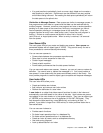Twinaxial ASCII printing
LAN ASCII printing
TCP/IP printing through the Send TCP/IP Spooled File command (known as
LPR or line printer requester in UNIX TCP/IP)
The API provides a programming interface to the same transform.
The QWPZHPTR API goes along with another function, the Print Driver exit
program. This exit program allows you to create your own print driver program.
For example, the system provides a print driver to communicate to LAN-attached
printers through the LexLink protocol. This print driver uses the host print transform
to convert the SNA-character-string spooled files or AFP spooled files to ASCII
before sending them to the printer.
With the QWPZHPTR API, you can write your own print driver (maybe to communi-
cate over a protocol other than LexLink), but still use the system-provided transform
(host print transform).
Spooled File APIs
Spooled file APIs obtain specific information about spooled files. For example,
spooled file APIs can:
Return a list of spooled files based on given selection criteria, such as a user
or an output queue.
Provide functions to access a specific spooled file from which the API can
return the attributes and data of a spooled file or create a duplicate of a specific
spooled file.
Spooled file APIs are useful in writing applications to clean up, save, and restore
spooled files.
Problem Management APIs
The problem management APIs offer you the ability to write problem management
solutions, improve serviceability, and manage your own applications. Problem
management APIs deal directly with how the AS/400 handles problems today.
Today, the problem log provides most of the operations necessary for problem
management in a network environment. These APIs have several capabilities:
Filtering
A filter categorizes problem log entries into groups and performs operations on
them accordingly.
The problem log applies the currently active filter to a problem log entry whenever a
problem entry is created, changed, or deleted using system-provided interfaces.
The operations supported allow you to send application notification to a user data
queue and assign the problem to a user. Your application can receive these notifi-
cations from the data queue using existing APIs.
8-18 System API Programming V4R1


















